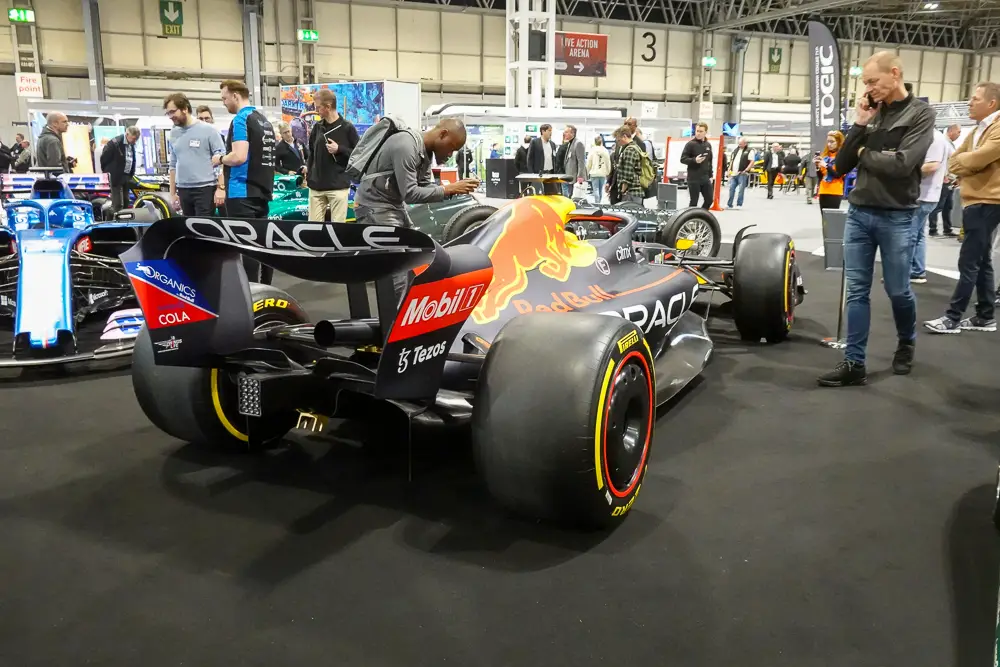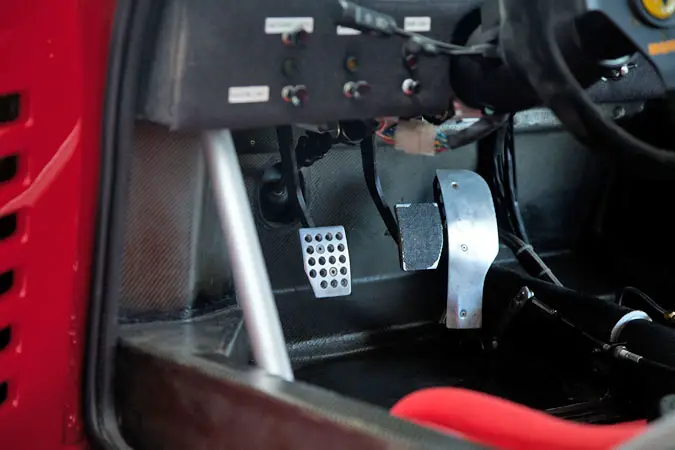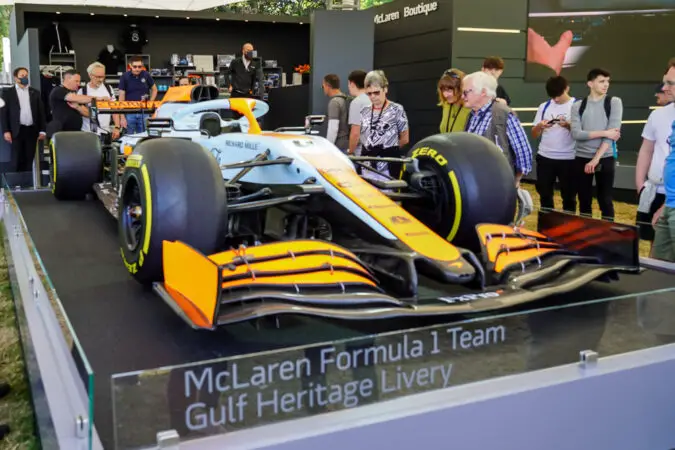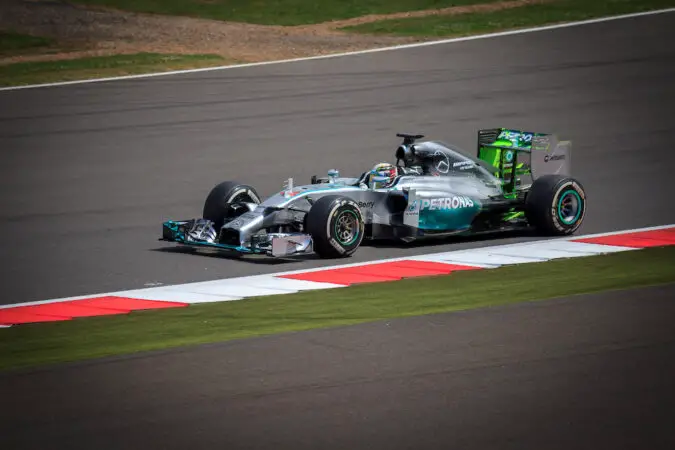The Formula 1 races have become a top attraction for the sport’s countless fans worldwide. The special designs and the powerful performance of F1 cars made F1 racing super interesting. F1 vehicles are renowned for their incredible speed and superb handling, but, like your usual car, do F1 cars have a clutch pedal?
Different events and competitions during the 1920s and 1930s in Europe inspired the formation of Formula 1. In 1946, the Federation Internationale de l’Automobile established the Formula One rules. The first world championship was held in 1950. This patchwork of races came to an end in 1983.
Most car enthusiasts have often wondered if these super-fast racers had clutches and clutch pedals. If they do, where are they located? This article will cover in detail several aspects of F1 cars, and if they utilize clutch pedals.
- How Fast Do F1 Cars Go?
- F1 Car Clutch
- Do F1 Cars Have A Clutch Pedal
- Formula 1 Car Engines
- F1 Transmission
- F1 Cars Through The Years
- Rules That Govern Formula One Racing
- Final Thoughts
- FAQs
How Fast Do F1 Cars Go
Formula 1 cars are indeed supercars (to find out more, you can check out our guide on Indy Car vs Formula 1); they can reach speeds up to 360 mph. That is largely due to its unique engineering that combines superb aerodynamics with lightweight building components.
Despite being so popular for its very fast cars, F1 doesn’t boast of fast acceleration (relative to their top speed), partly because they weren’t built for straight-line acceleration. F1 cars are small and are built to ply circuits at high speeds. That is if the racing driver adheres strictly to the safety instructions provided by the regulatory body (if you too want to learn how to become a race car driver).
For some reasons, which include tire preservation, F1 cars aren’t made to accelerate briskly. Fast acceleration takes its toll on tires because of irregular forces acting on them and causing them to wear away quickly. Hence, putting the driver and other racers at risk should tire suddenly disengage during a race.
F1 Clutch System
To better understand the clutching mechanism of F1 cars, we would need to understand the basic meaning and importance of the device called “clutch.” So, what is a clutch, and do F1 cars have a clutch pedal?
A clutch acts as a bridge between a vehicle’s engine and the transmission. It helps your car to achieve a seamless transition and avoid jerky situations when you want to change gear. It achieves that by temporarily disconnecting the engine.
Advanced machines like F1 cars come clad with a clutching system that’s very different from other vehicles. Do F1 cars have a clutch pedal? manufacturers designed clutches in F1 vehicles to allow the drivers to shift gears with the utmost power while maintaining their pace.
Do F1 Cars Have A Clutch Pedal: A Regular Car Clutch VS An F1 Car Clutch
Many differences exist between a normal car clutch and an F1 car clutch. A car clutch weighs about 50 kg and is usually made of cast iron or carbon steel. An F1 car clutch weighs only 1.5kg and is composed of carbon fiber elements and titanium metal.
Normal cars usually come with a single disc clutch, while an F1 car’s clutch comes with about 3 – 4 discs. Due to their high speeds, F1 car clutches have a high-temperature resistance of 500oC. Due to its clutch’s extreme use conditions, it doesn’t last long. Hence, the need to replace it frequently.
Do F1 Cars Have A Clutch Pedal: How It All Works
It’s normal for vehicles with manual transmission to utilize clutch pedals for selecting gears, but do F1 cars have a clutch pedal? Older F1 cars before the 1990s have clutch pedals.
However, modern F1 cars don’t have clutch pedals as it reduces the number of pedals drivers must deal with while making split-second decisions during racing. Rather, they have levers that are usually attached beneath the steering wheel for easy reach using the hands.
Operating an F1 clutch is also different from an ordinary car because, in an F1, the driver stretches or pulls a lever. A hydraulic actuator operates the clutch electro-hydraulically. Hence, it’s a semi-automatic transmission mechanism. While racing, you don’t have to press the clutch to change gear, because it does that automatically.
What Engines Do Formula 1 Cars Use
Modern Formula 1 cars use 1.6-liter V6 engines with turbochargers and hybrid electric technologies. Despite the strict rules set by the FIA, the F1 governing body, F1 engines are subject to great experimentation and innovations by the different teams participating in a Grand Prix event.
Some participants, like Mercedes, Ferrari, and Renault, do manufacture their own engines. In contrast, others, like Red Bull, McLaren, Racing Point, Alfa Romeo, Alpha Tauri, Haas, and Williams, buy engines from the engine manufacturers mentioned above and others like Honda.
The FIA placed strict regulations on the type of engines used by different teams for grand Prix events. The 1.6 liters six-cylinder engine has been in use since 2014. It replaced the 2.4-liter V8 engine, which consumed more fuel and, as expected, yielded a greater power output at about 20,000 revolutions per minute (RPM).
This change in engine type has yielded some advantages, including increased fuel efficiency by about 35–40%. The presence of a turbocharger increases the density of air consumed and hence significantly increases engine power output. This V6 1.4-liter engine is capped at 15,000 rpm for safety reasons by the FIA.
How Much Horsepower Does A Formula One Car Have
Formula 1 V6 engines produce about 850 horsepower and consume just 110kg of fuel in races, equivalent to about 135 liters.
It features a direct injection hybrid system (ERS) that converts kinetic energy recovered from braking and heat energy from the turbocharger (ERS-K and ERS-H) back to electrical power. The engine can use that to provide more horsepower. This hybrid system alone adds about 161 extra horsepower to the modern Formula One car.
F1 Transmission
Before switching to automatic versions in 1989, manual transmission systems were used by F1 cars. Ferrari was the first company to use fully automated transmission systems. After introducing fully automated transmission systems, different racing companies switched to an entirely automatic mode. That automated the gear shifting process for each turn in a race.
That was made possible through radio beacons set along the track to determine the vehicle’s location and automatically shift to the preprogrammed gear level.
They discontinued that after some racing drivers gave bad reviews on how the beacons were jacked and inaccurate. Rules which allowed drivers to tune their cars made the use of automated beacons phase out. They now consider fully automatic gearboxes illegal.
Do F1 Car Have A Clutch Pedal: Manual Or Automatic?
Modern F1 cars use a semi-automatic transmission system. This system allows the driver to switch between gears using paddle shifters swiftly. This semi-automated transmission system is by far the most efficient used in F1 races. It allows drivers to shift gears faster than what would be obtained if clutch pedals were present.
Shifting upwards can be done automatically as far as we can tell, but down gear shifts will have to be done manually by the racing driver. There is presently no launch control available in modern Formula One cars.
Do F1 Cars Have A Clutch Pedal: How Many Gears Do F1 Cars Have
Formula One cars come clad with an 8-level forward gear system with a reverse gear. Drivers rarely use the reverse gear.
Do F1 Cars Have A Clutch Pedal: F1 Car Steering Wheel
There are a few primary applications for an F1 steering wheel. The direction of the steering wheel determines the direction of the wheels. Even though modern F1 cars have power-assisted steering, the wheel still gives tactile feedback on front-wheel traction.
Due to their direct steering, large turning circles, and tight cockpits, F1 cars have a limited range of steering motion, around 180 degrees from straight ahead to full lock.
Modern F1 cars have paddle shifters on the left and right sides of the main wheel that is used to shift gears sequentially. The left paddle shifts gear downward, while the right paddle shifts gear upward.
F1 cars feature a manual paddle clutch, only used when starting from a standstill (at the start of the race, after a pit stop, or after a spin) and not when shifting gears. When we used numerous clutch paddles to select and release the clutch before current constraints, it was possible to have a better bite point and a more precise release.
Do F1 Cars Have A Clutch Pedal: Adjustable Features In F1 Cars’ Steering Wheels
- Ignition timing
- Fuel flow
- RPM limit
- Hybrid energy recovery
- Drivers may alter the amount of slip in F1 cars’ fluid dynamics
- Adjusting the front-to-rear brake balance is rather typical
- Regenerative braking affects the feel of the brakes and the charging rate of the hybrid battery, which can all be tuned
- F1 cars also feature rotary switches that may be used to change many parameters at once
- Drivers can access a menu system that allows them to tweak most individual settings
What You Can Do With F1’s Steering Wheel:
To control the Drag Reduction System (DRS): DRS controls the angle or location of the rear wing flap to reduce drag and increase peak speed. You can activate and deactivate this feature by pushing the buttons on the steering wheel.
Radio your team: Press a button to radio to the external crew or team.
Activate the onboard dispenser: Also, you can activate the onboard drink dispenser which connects to the driver’s helmet through a bottle in the car, by pressing a button.
Pit lane: F1 pit lanes have a speed restriction. Drivers must reduce their speed by pressing a button that helps reduce their speed before pitting the car to avoid going against the pit lane speed restriction as stipulated by the FIA (Formula One’s World Regulatory Body).
The wheel also has a digital display that displays data such as lap times, fuel efficiency, and other metrics. The Marshal’s flags and rev/gear change lights have independent LED displays.
Differences Between Commercial Cars And An F1 Car
These are some of the differences that might help you have a better grasp of the difficult engineering challenges that are present in motorsports.
Comparing a spacecraft to a regular airplane will help further simplify this. A Formula One racing vehicle is more akin to a regular airplane than a spacecraft. They push the boundaries of what is physically possible. It could even seem like they violate the rules of physics when you first look at them.
The engines in Formula One cars have a capacity of 1.6 liters, which is comparable to that of the engines found in most commercial vehicles. However, these 1.6-liter engines generate 5–6 times the power and 4–5 times the torque of their commercial counterparts.
The vehicle aerodynamics of Formula One racing cars are designed to be the complete antithesis of those of a regular family automobile.
Even though they only have a few moments of life, the tires produce a level of traction that even the tires of a hypercar cannot achieve while traveling at normal speeds. The list of how an F1 vehicle and a road car are distinct could go on and on.
F1 Car Specification In Comparison With Stock Cars
Manufacturers use top-tier technologies to make Formula One cars. They are designed with the highest possible level of accuracy with the end goal of winning a world championship. F1 cars cut through the air and compete on very difficult racing tracks all over the globe.
On the other hand, they build stock cars for speed, often producing more than 850 horsepower and achieving speeds of more than 200 miles per hour on oval racing circuits around the United States. They weigh more and have a more substantial build than a Formula One vehicle. Stock cars don’t compete on streets and roads as regularly as F1 cars; when they do, they don’t handle turns.
Stock vehicles can’t keep up with Formula 1 cars regarding maneuverability and acceleration out of the turns. Therefore, stock vehicles are much slower and heavier than Formula One cars without getting too technical. They also employ a manual gearbox with four gears, unlike the F1 drivers who use paddle shifters on their steering wheels, which significantly cuts down the time between gear shifts.
F1 Cars Through The Years
There have been great improvements in the design and performance of F1 cars since motorsports’ inception in 1950.
On a performance basis, one of the first notable cars used in grand Prix events and won races was the Alfa Romeo 158s. They were the unbeatable kings during the May 13, 1950, race. These cars finished 1st, 2nd, and 3rd respectively while leaving other cars 2 laps behind. They used In-line 8-cylinder supercharged engines and generated 350 horsepower at 8,500 revolutions per minute. Their lifespan was, however, cut short as there were no funds to produce and maintain them.
Another notable F1 car we have to talk about is the Ferrari F2002. It won over 90% of its races. This car featured a massive 10-cylinder V10 3-liter engine, yet it wasn’t the fastest during its time but was notable because of its superb handling. Ferrari introduced this car in 2002.
The Redbull RB9 introduced in 2012 was a wonder to behold as it broke world records with only a “fairly good engine.” It was super-fast and won 13 out of its 19 races. Engineers often wonder how fast this F1 car would have been if it featured the advanced engines available in 2012.
Recently, racing companies and engineers have developed more powerful cars and engines, with millions of dollars going into research. Mercedes stands out for the invention of the best F1 car engine on today’s grid.
More aerodynamic body designs have made F1 cars generally faster. That also gave it better handling than what we had during Formula One’s early years. Performance is a major determinant in Grand Prix events. Hence, these technological improvements have become an inevitable part of F1 cars.
Rules That Govern Formula One Racing
Here are some basic rules that guide racing events.
- Starting from a grid, cars compete in a race with a set number of laps and tire changes.
- Aggressive blocking and weaving are also prohibited, as is an intentional car-to-car collision.
- Drivers can take a defensive stance if they don’t make sudden changes in speed or direction.
- Infractions do not influence play.
- Each team must construct its chassis following rigid weight, material, wing size, and position requirements.
The Car Rules Include
- The cockpit and nose shapes are determined using crash safety rules.
- The chassis has to be unique.
- The vehicle must use the format: mid-rear engines, open wheels, and open cockpits.
- Vehicles cannot use automatic transmissions, active suspension, traction control, ABS, or launch control.
- The driver can change differentials, brake balance, and engine modes.
- Engines must be 1.6-liter hybrid turbocharged V6s with regenerative braking. (Performance varies across engine producers)
- The industry standard for tire compounds is 5 dry and 2 wet
- Although they can radio drivers, engineers cannot remotely modify autos (they can collect data in real-time and use that to advise drivers).
Other Rules Include
- First up is the fastest qualifier from Saturday.
- The game requires two different tires (unless wet tires are used).
- The competition forbids refueling during an ongoing race.
- If a driver is fewer than one second behind the leading car, he is allowed to increase the vehicle’s straight-line speed by using a drag-reduction tactic.
- The winning lap is the final one.
- Yellow flags mean the drivers should slow down and refrain from passing
- Safety car: as the name implies, it requires the racing drivers to follow the safety car at a low speed in a tight formation. You can use that to control the race in accidents or bad weather.
- The pit lane is open until the game ends.
Driver Rules
- Although racing accidents are not subject to penalties, intentional or negligent automobile contact is illegal.
- Driving off the course doesn’t improve lap times or overtaking (all 4 wheels over the white lines).
- The game does not permit drivers to swerve and obstruct other vehicles, drivers are free to take any path around the track (within track limitations),
- The rule prohibits drivers from abruptly changing lanes during braking sections, or driving aggressively, dangerously, or inconveniently.
- The vehicle in front has the right-of-way and may take any path, but oncoming traffic must give it enough room and not push it off the track.
- Disqualification from one or more races or the season, time penalties during pit stops, and fines are some examples of time penalties. A racing suspension could happen for minor violations.
- Unlike sports officials, race stewards apply driving laws retroactively and subjectively.
- The game permits subjective interpretation, and will not stop the race from investigating a potential infraction.
Championship Rules
- The position is scored (and nothing else). The first position receives 25 points; the second position receives 18 points, and so forth.
- Vehicles finishing in the bottom ten don’t receive points.
- The team and driver both receive points.
- Two vehicles per team (with separate drivers) is the standard.
- Teams and drivers compete. The first and second places in a race can earn a team 43 points.
- Sometimes, drivers can disobey directives from teams to open lanes for one another. Drivers can slow down traffic.
F1 Car Clutches: Facts You Need to Know
- F1 cars do have clutches, but they are not traditional pedal clutches found in road cars.
- The F1 clutch is located on the steering wheel and is controlled by the driver’s hands or fingers.
- F1 cars use highly automated sequential semi-automatic gearboxes with paddle shifters.
- F1 cars have eight forward gears and one reverse gear.
- F1 cars’ clutches are engaged using hydraulic actuators and sensors, with the exception of the first gear when launching from a standstill.
- Traction control, launch control, and fully-automatic gearboxes have been banned in F1 since 2004 and 2008 to keep costs down and maintain driver skill and involvement.
- F1 cars shift rapidly because the onboard computer can make gear changes in under 50ms.
- F1 drivers shift gears using paddles located behind the steering wheel.
- The elimination of clutch pedals in F1 cars was introduced by Ferrari in 1989 with the Type 640 F1 car.
- F1 drivers only engage the clutch at the start of the race, and shortly after, the clutch pedal becomes another paddle on the steering wheel.
Final Thoughts On Do F1 Cars Have A Clutch Pedal
Formula 1 racing vehicles have clutches like other cars, even though their operation is widely different from normal cars.
Modern F1 cars replaced clutch pedals with a semi-automatic transmission system, and a clutch paddle located under the steering. That reduces the number of pedals drivers have to deal with. Having paddles instead of pedals makes gear transitioning smoother and faster, as even a fraction of seconds matters in Grand Prix events.
FAQs On Do F1 Cars Have A Clutch Pedal
Here are some popular FAQs:
Which Pedal Is The Brake
Conventionally, the brake pedal is most usually located to the left. You can operate it using only the right leg. It is, however, possible that certain cars have it the other way round, but this is on rare occasions.
How Does A Clutch Work
A clutch has two flat and round metal plates that are spring-loaded, so friction forces the other plate to revolve when one plate is turned. Clutching causes the plates to separate, disconnecting the engine rotation from the wheels and allowing the gears to engage at lower speeds.
Do Automatic Cars Have A Clutch
No. In the conventional sense, there is no clutch in an automatic gearbox car. The torque converter performs this function. It is attached to the rear of the engine.
What Is A Clutch In A Car
A clutch consists primarily of two metal plates, one flat and the other round. It is spring-loaded so that when one plate is moved, the friction causes the other plate to spin in response. You will find clutches and clutch pedals in manual transmission cars.
How Fast Are Formula 1 Cars
Formula One cars have become faster in recent years. They can reach top speeds of up to 230MPH. Overall, F1 is fast and also accelerates very fast too. They can go from 0 to 60MPH in about 2.5 seconds.





